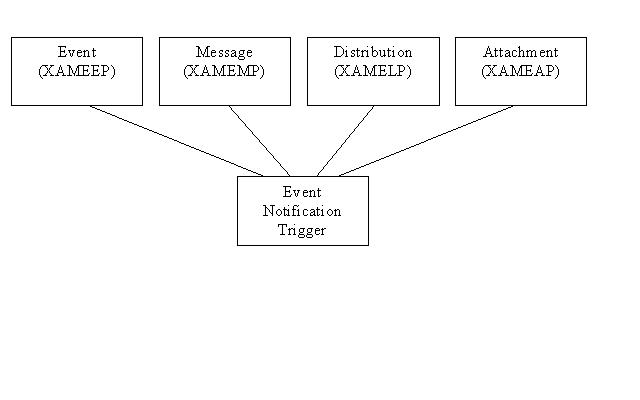Using event notification triggers is a smart, simple, cost-effective way to improve productivity.
The concept behind event notification triggers is fairly simple. As the name suggests, the goal of implementing event notification triggers is to provide "notification" to someone when a significant business "event" occurs. This is a proactive means of "pushing" information from the system. This may come in the form of a simple email message. However, the benefits of a simple message are limited.
The challenges are to make it flexible enough to meet the needs of virtually any event, to include intelligent information from your enterprise systems, and to make it technically simple enough for it to be cost-effective to implement anywhere within your enterprise systems. In this article, we will explore what it takes to implement event notification triggers.
Consider your situation. Your company has an integrated system that collects accurate information in real time in the key functional areas of your business. This is a great accomplishment. Yet you look around and see that human-intensive manual processes are happening everywhere every day. This should make you think. Is your system providing value only for financial reporting and business analysis? Don't get me wrong. These are critical aspects of any business. But since you have this great system in place, why not provide real-time value to the areas that keep your business running on a day-to-day basis? Event notification triggers are a simple way to begin.
Hopefully, you noted this above, but just to be sure, here is a simple description of an event notification trigger: When a significant business event occurs, notify the appropriate people with the information necessary to take action (or for informational purposes only).
Here are a few examples to get you thinking:
•· A transaction has caused the available inventory quantity on a critical product to drop to zero. Notify the materials manager with the item number, description, date, time, and an intelligent message.
•· Your normal delivery time for stock products is within 48 hours, but an order has been accepted that requires same-day delivery. Notify picking and shipping with the order number, customer name, item number, description, quantity, and a PDF attachment of the order or pick slip.
•· Consider a workflow example. A requisition has been entered. Based on its dollar value, it must be approved by a manager. Notify the manager that a requisition is pending approval. Once approved, notify the buyer to convert it to a purchase order. Once the purchase order is created, notify the requisitioner of the PO number and expected delivery date. Once the item is received, notify the requisitioner that it has been received.
Contrast these examples with the way things are happening now. You get nightly (next morning) reports of products with available inventory quantity of zero, and then you take action. When an order is taken for same-day delivery, your order entry person walks the order or pick slip out to shipping or calls shipping with this information. The list of examples abounds across departments. Only by working with the people who do the job daily can you determine what benefits will come from having the knowledge in real time.
OK, now that I've got your mind going, let's work through building the architecture necessary to make this work. There are just a few setup tasks, a relatively simple database, and three programs (functions) that perform all of the work.
Setup
Setup requires three things:
•· Access to an email server--Any area of your system that will be allowed to trigger an event notification must have access to an email server. On the System i, set up the SMTP email service.
•· Access to a disk location for attachments--Standard (reusable) attachments must have an accessible place to reside so that the event messages can use them.
•· Tool to generate PDF documents--Any spooled file to be sent can be placed into a dynamic email attachment once it is converted to a PDF.
Database
Here's what you'll need for your database:
•· Event master file--Define the event with an accurate business description.
•· Message file--Define the text of the message, the format, and the variable data to be included.
•· Distribution list file--Define the list of people to receive the message.
•· Attachment file--Define the location of the attachment(s) to be included.
•· Event notification trigger file--Tie all of the above pieces together (event, message, distribution, attachment).
Figures 1 and 2 below show what your database structure and file layouts should be.
Figure 1: Your database should be structured like this. (Click images to enlarge.)
FILE : XAMEEP Event Master
LIBRARY: MC@EDDF
FORMAT : XAMEEP Event Master
DEC
FIELD NAME FIELD DESCRIPTION FROM TO LEN TYP POS
---------- ------------------------------ ----- ----- ----- --- ---
ENEVNT Event Identification 1 10 10 A
LANG Language Code 11 13 3 A
ENEVDS Event Description 14 63 50 A
ENEVED Event Extra Description 64 113 50 A
USRX Created/Updated by User 114 123 10 A
CYDX Date Created/Updated 124 131 8 S 0
TIMX Time Created/Updated 132 137 6 S 0
FILE : XAMEMP Event Message Master
LIBRARY: MC@EDDF
FORMAT : XAMEMP Event Message Master
DEC
FIELD NAME FIELD DESCRIPTION FROM TO LEN TYP POS
---------- ------------------------------ ----- ----- ----- --- ---
ENMSID Message Identification 1 10 10 A
LANG Language Code 11 13 3 A
ENMSSQ Message Sequence 14 15 3 P 0
ENMSTX Message Text 16 85 70 A
ENEOLN Message End-of-Line Indicator 86 86 1 A
USRX Created/Updated by User 87 96 10 A
CYDX Date Created/Updated 97 104 8 S 0
TIMX Time Created/Updated 105 110 6 S 0
FILE : XAMEAP Event Notification Attachments
LIBRARY: MC@EDDF
FORMAT : XAMEAP Event Notification Attachments
DEC
FIELD NAME FIELD DESCRIPTION FROM TO LEN TYP POS
---------- ------------------------------ ----- ----- ----- --- ---
ENATID Attachment ID 1 10 10 A
ENATLN Language Code 11 13 3 A
ENATSQ Attachment Sequence 14 15 3 P 0
ENATPT Attachment Path (IFS) 16 85 70 A
ENATFN Attachment Filename 86 155 70 A
USRX Created/Updated by User 156 165 10 A
CYDX Date Created/Updated 166 173 8 S 0
TIMX Time Created/Updated 174 179 6 S 0
FILE : XAMELP Event Distribution List Master
LIBRARY: MC@EDDF
FORMAT : XAMELP Event Distribution List Master
DEC
FIELD NAME FIELD DESCRIPTION FROM TO LEN TYP POS
---------- ------------------------------ ----- ----- ----- --- ---
ENDLID Distribution List Identifier 1 10 10 A
ENDLSQ Distribution List Sequence 11 12 3 P 0
ENDLTY Distribution List Type 13 15 3 A
ENMAIL Email Address 16 65 50 A
LANG Language Code 66 68 3 A
USRX Created/Updated by User 69 78 10 A
CYDX Date Created/Updated 79 86 8 S













 Business users want new applications now. Market and regulatory pressures require faster application updates and delivery into production. Your IBM i developers may be approaching retirement, and you see no sure way to fill their positions with experienced developers. In addition, you may be caught between maintaining your existing applications and the uncertainty of moving to something new.
Business users want new applications now. Market and regulatory pressures require faster application updates and delivery into production. Your IBM i developers may be approaching retirement, and you see no sure way to fill their positions with experienced developers. In addition, you may be caught between maintaining your existing applications and the uncertainty of moving to something new. IT managers hoping to find new IBM i talent are discovering that the pool of experienced RPG programmers and operators or administrators with intimate knowledge of the operating system and the applications that run on it is small. This begs the question: How will you manage the platform that supports such a big part of your business? This guide offers strategies and software suggestions to help you plan IT staffing and resources and smooth the transition after your AS/400 talent retires. Read on to learn:
IT managers hoping to find new IBM i talent are discovering that the pool of experienced RPG programmers and operators or administrators with intimate knowledge of the operating system and the applications that run on it is small. This begs the question: How will you manage the platform that supports such a big part of your business? This guide offers strategies and software suggestions to help you plan IT staffing and resources and smooth the transition after your AS/400 talent retires. Read on to learn:
LATEST COMMENTS
MC Press Online